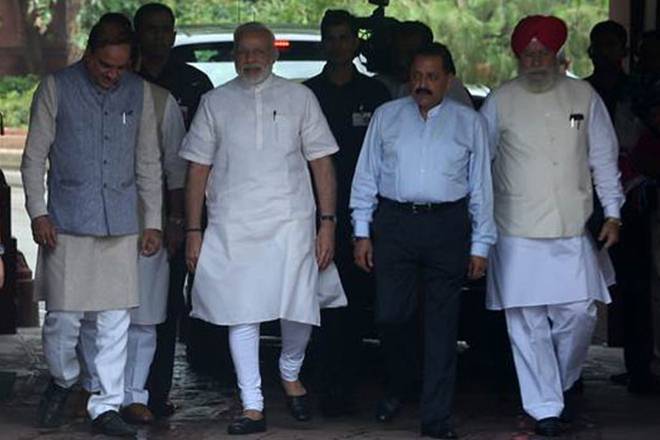With more anti-black money moves, GST, here’s what will make 2017 an interesting year
The Financial Express
By Bibek Debroy
December 31, 2016 6:37 AM
As a mathematical factoid, 2017 is a prime number. It, therefore, has two divisors, 1 and 2017 and the sum of the divisors is 2018.

As a mathematical factoid, 2017 is a prime number. It, therefore, has two divisors, 1 and 2017 and the sum of the divisors is 2018. (Source: IE)
As a mathematical factoid, 2017 is a prime number. It, therefore, has two divisors, 1 and 2017 and the sum of the divisors is 2018. From this, one might deduce the ramifications of what occurs in 2017 will spill over into 2018, and perhaps beyond. There are plenty of external events that will affect India—a new US president, US Fed action, Brexit vote, elections in European countries and Opec decisions on oil production. There is a long list of elections due in Indian states, too—Punjab, UP, Uttarakhand, Manipur, Goa, Gujarat, Himachal Pradesh—some more important politically than others. Those political outcomes will inevitably affect economic decision-making.
In the narrower domain of policy-making and governance, consider the following. First, there will be major changes in the budgetary process—the abolition of the Plan versus non-Plan distinction, factoring in by state governments of this, recommendations of the 14th Finance Commission (with State Finance Commission recommendations) and restructured centrally-sponsored schemes, abolition of the Railway Budget as we have known it (with some form of a regulator/development authority established) and the bringing forward of the Union Budget (with some decision subsequently about change in the fiscal year). Second, irrespective of whether one can stick to the April-1 deadline, in the course of FY18, there will be transition to GST. Beyond the rates, this will widen the tax base, at least the indirect tax part. Third, on February 1, we will know whether direct tax rates will change, spliced with removal of exemptions and a more transparent system that reduces compliance costs. In the process, we might hopefully bring taxing of agricultural income (above a threshold) into the discourse, not to forget that non-agricultural income of farmers is also not taxed in the process. Fourth, many government initiatives on improving doing business rankings weren’t reflected in World Bank’s Doing Business indicators for 2016. This is not meant to imply an inordinately high emphasis on such rankings, but to accept that India’s ranking should significantly improve in 2017.
Fifth, getting beyond speculation on what the impact of November 8, 2016, has been on GDP growth, we will get a better handle on the numbers, for Q3 and Q4 of FY17, and some prognosis for FY18. The dampening in the second half of FY17 should be offset by higher growth in FY18. We will also have a firmer view of RBI’s stance on growth, inflation and policy rates. Sixth, with better numbers (after end-December), one will know how many high denomination notes have been extinguished (with a reduction in RBI’s liabilities) and how many have been brought into the banking system.
By March 31, 2017, one will know about numbers for Pradhan Mantri Garib Kalyan Yojana. But even before that, on February 1, one will know what the government intends to do with taxes and penalties that have incrementally come into the Consolidated Fund of India. Stated in different language, there is a case for public investments, often required to catalyse private investments. These assorted strands fit into the broader canvas of an investment revival and growth recovery. Seventh, the November 8 measure was only one instrument in a package the government contemplated to address creation of new black income, as well as address stock of black wealth not held in the form of cash. Some measures (Mauritius, Benami Property Transactions Prohibition Act) have already been announced. But clearly, more (gold, real estate, funding of capital market transactions) are in the offing, with even some straws in the wind about electoral reform entering the discourse.
Money being brought into the banking system by the end of December doesn’t mean “black” has turned “white”. Other than taxes and penalties, questions will inevitably be asked about origins of such income. Therefore, spliced with the widened GST base, whenever that occurs, the government will presumably announce safeguards that an unintended tax inspector raj isn’t unleashed.
Eighth, demonetisation and associated measures aren’t only about an institutional cleaning up, they are also about a churn. We will see the beginnings of this in 2017. Will more people start to use non-cash instruments? In the process, with increasing use of smartphones, will there be a switch from pre-paid to post-paid? Will poor people realise that pieces of plastic linked to Pradhan Mantri Jan-Dhan Yojana accounts can be used for transactions other than ATM withdrawals? Will more financial products and DBT persuade people to use these accounts more? How will privacy and data security issues be handled? With micro ATMs and bank mitras, will banks find classic ATMs to be commercially viable?
Incrementally, will there be greater formalisation of transactions, enterprises and workers? This government came into being in May 2014, and 2017 is its third year. There has been a conventional view that beyond the third year, substantial “reforms”, however defined, don’t occur. In addition to that, because of the reasons mentioned, 2017 promises to be an interesting year.